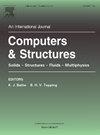Robustness of a flux-intensifying permanent magnet-assisted synchronous reluctance machine focusing on shifted surface-inset ferrite magnets
IF 4.8
2区 工程技术
Q1 COMPUTER SCIENCE, INTERDISCIPLINARY APPLICATIONS
引用次数: 0
Abstract
Flux-intensifying permanent magnet-assisted synchronous reluctance machines use relatively small amounts of non-rare earth permanent magnets, making them viable alternatives for remanufacturing older machines, aligning with EU directives and circular economy principles. The asymmetric rotor topology is particularly suited for micromobility applications, which benefit from shifting inset magnets, as reverse motoring is rarely required. However, this design could be more sensitive to manufacturing and positioning errors of the magnets. To investigate the effects of the uncertainties of the shifted surface inset magnets, first, an optimal topology is selected based on average torque, torque ripple, and cogging torque using the NSGA-II optimisation method. The effects of the magnet shifting and its robustness are analysed using the Taguchi and ANOVA methods, validated by Full Factorial calculations. Results indicate a 31.25 % reduction in permanent magnet volume without compromising torque output with magnet shifting. The machine’s average and cogging torque remain within a 5 % robustness threshold for a 0.06 mm discrete manufacturing tolerance. Torque ripple may exceed this limit up to 14.77 %. However, the likelihood of exceeding the threshold is only 12.10 %. The reduced magnet volume and maintained performance make this topology a promising option for remanufactured machines in micromobility applications, supporting circular economy goals.
聚焦于移位表面插入铁氧体磁体的磁通强化永磁辅助同步磁阻电机的鲁棒性
磁通强化永磁辅助同步磁阻电机使用相对少量的非稀土永磁体,使其成为再制造旧机器的可行替代方案,符合欧盟指令和循环经济原则。不对称转子拓扑结构特别适合于微移动应用,它受益于移动插入磁铁,因为很少需要反向电机。然而,这种设计可能对磁体的制造和定位误差更敏感。为了研究移位表面插入磁体不确定性的影响,首先,采用NSGA-II优化方法,基于平均转矩、转矩脉动和齿槽转矩选择最优拓扑结构。使用田口和方差分析方法分析了磁体移动的影响及其稳健性,并通过全析因计算进行了验证。结果表明,在不影响转矩输出的情况下,永磁体体积减少31.25 %。机器的平均和齿槽扭矩保持在±0.06 mm离散制造公差的5 %稳健性阈值内。转矩波动可能超过此限制,高达14.77 %。然而,超过阈值的可能性仅为12.10 %。减少的磁铁体积和保持的性能使这种拓扑结构成为微移动应用中再制造机器的一个有前途的选择,支持循环经济目标。
本文章由计算机程序翻译,如有差异,请以英文原文为准。
求助全文
约1分钟内获得全文
求助全文
来源期刊

Computers & Structures
工程技术-工程:土木
CiteScore
8.80
自引率
6.40%
发文量
122
审稿时长
33 days
期刊介绍:
Computers & Structures publishes advances in the development and use of computational methods for the solution of problems in engineering and the sciences. The range of appropriate contributions is wide, and includes papers on establishing appropriate mathematical models and their numerical solution in all areas of mechanics. The journal also includes articles that present a substantial review of a field in the topics of the journal.
 求助内容:
求助内容: 应助结果提醒方式:
应助结果提醒方式:


